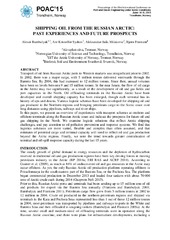Shipping oil from the Russian Arctic: Past experiences and future prospects
Permanent lenke
https://hdl.handle.net/10037/8605Dato
2015-06Type
Journal articleTidsskriftartikkel
Peer reviewed
Sammendrag
Transport of oil from Russian Arctic ports to Western markets was insignificant prior to 2002.
In 2002, there was a major surge, with 5 million tonnes delivered westwards through the
Barents Sea. By 2004, this had increased to 12 million tonnes. Since then, annual volumes
have been on levels between 9 and 15 million tonnes. In the near future, the flow of oil cargo
in the Arctic may rise significantly, as a result of the development of oil and gas fields and
port capacities in the North. Oil offloading terminals in the Russian Arctic have been
developed and overall shipping capacity has been enlarged, though each terminal has its
history of ups and downs. Various logistic schemes have been developed for shipping oil and
gas produced in the Northern regions and bringing petroleum cargo to the Arctic coast over
long distances using pipelines, railways and river ships.
In this paper, we present an overview of experiences with transport schemes at onshore and
offshore terminals along the Russian Arctic coast and indicate the prospects for future oil and
gas shipping in the North. We examine logistic solutions that reflect Arctic shipping
challenges, and pay attention to oil pollution prevention and response systems. We find that
logistics solutions are more varied, flexible and complex than often assumed, and that
estimates of potential cargo and terminal capacity will need to reflect oil and gas production
beyond the Arctic regions. Finally, we note the trend towards greater centralisation of
terminal and oil-spill response capacity during the last 15 years.


 English
English norsk
norsk